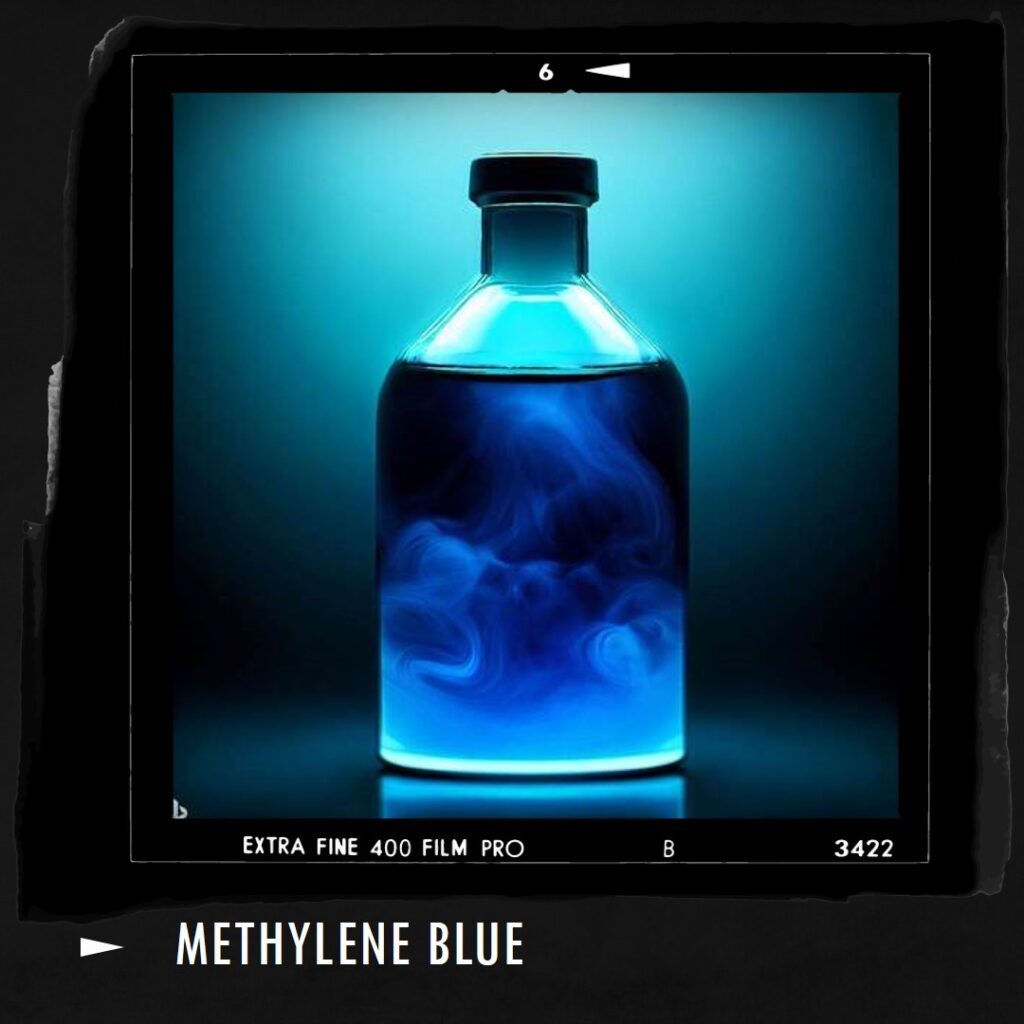FREE SHIPPING OVER $50
The Power of Methylene Blue: Preventing Disease and Enhancing Health
Methylene blue, a remarkable compound known for its deep blue hue, goes beyond its role as a dye. This article uncovers the extensive power of methylene blue in disease prevention and the enhancement of long-term health. From its versatile applications to its notable benefits, we explore the mechanisms and potential of methylene blue in promoting overall well-being.
The Origins and Uses of Methylene Blue

Methylene blue, a synthetic dye initially developed in the mid-19th century, has found diverse applications across several fields. Its vivid blue color has made it indispensable in staining laboratory specimens, but its capabilities extend far beyond its aesthetic appeal.
It has been used as a diagnostic tool, aiding in the visualization of certain structures during medical procedures. Methylene blue has also been employed in the treatment of various conditions, such as methemoglobinemia, a blood disorder, and as an antidote for cyanide poisoning. Furthermore, recent research has explored its potential therapeutic applications in neurodegenerative diseases and certain types of cancer.
It has also found applications beyond medicine and biology. It has been used in photography as a color filter, as well as in wastewater treatment processes due to its ability to remove certain pollutants.
How Methylene Blue Works
Methylene blue is a fascinating compound that exerts its effects through various mechanisms in the body. Let’s delve into how it works:
- Cellular Energy Production: Methylene blue can enhance cellular energy production by promoting mitochondrial function. Mitochondria are often referred to as the “powerhouses” of cells, responsible for generating the energy needed for cellular processes. It helps optimize mitochondrial function, leading to increased energy production and improved overall cellular health.
- Antioxidant Activity: Another remarkable property is its antioxidant activity. It acts as a potent scavenger of free radicals, which are unstable molecules that can cause damage to cells and contribute to various diseases. By neutralizing free radicals, methylene blue helps reduce oxidative stress and protect cells from damage.
- Neuroprotective Effects: Methylene blue has shown promise in supporting brain health and protecting against neurodegenerative diseases. It has been found to enhance brain function, improve memory, and potentially slow down the progression of conditions such as Alzheimer’s and Parkinson’s disease. These neuroprotective effects are thought to be linked to their ability to enhance mitochondrial function and reduce oxidative stress.
- Anti-inflammatory Properties: Chronic inflammation is a common factor in many diseases, and methylene blue has demonstrated anti-inflammatory properties that can help combat inflammation in the body. By modulating inflammatory responses, it may contribute to the prevention and management of various inflammatory conditions.
Understanding the mechanisms of methylene blue allows us to appreciate its potential benefits for preventing disease and promoting long-term health. Its ability to enhance cellular energy production, act as an antioxidant, support brain health, and reduce inflammation makes it a fascinating compound worthy of further exploration.
Methylene Blue Benefits

Disease Prevention
Methylene blue holds promise in disease prevention, thanks to its multifaceted effects on various aspects of health which include:
- Neurodegenerative Diseases: Methylene blue has demonstrated neuroprotective effects and has shown promise in preventing or correcting neurodegenerative diseases, such as Alzheimer’s disease and Parkinson’s disease.
- Cardiovascular Diseases: Methylene blue’s antioxidant properties may help reduce the risk of cardiovascular diseases, including heart disease and stroke.
- Mitochondrial Disorders: Methylene blue has shown potential in supporting mitochondrial function, making it beneficial in preventing or correcting mitochondrial disorders.
- Age-related Cognitive Decline: By enhancing cognitive function and memory, methylene blue may help prevent or correct age-related cognitive decline and improve overall brain health.
- Anti-aging properties: Methylene blue, known for its multifaceted capabilities, extends its embrace to the realm of anti-aging. By stimulating mitochondrial function, this compound aids in enhancing energy production within skin cells. This surge of energy breathes new life into tired cells, promoting collagen and elastin synthesis—a dynamic duo that lends your skin its resilience and suppleness.
- Inflammatory Conditions: Methylene blue’s anti-inflammatory properties make it a potential therapeutic option for preventing or correcting inflammatory conditions, such as arthritis and certain autoimmune diseases.
- Cancer: Research indicates that methylene blue exhibits promising anticancer properties, making it a potential candidate for cancer treatment. Although further studies are required to comprehensively comprehend its effects and potential applications in cancer therapy, these preliminary findings offer hope for innovative approaches to combatting this disease.
Methylene Blue as a Therapeutic Agent
Beyond disease prevention, methylene blue shows potential as a therapeutic agent in specific medical conditions. We examine some of its applications below:
- Treating Methemoglobinemia: Methylene blue is a primary treatment for methemoglobinemia, a condition where the blood cannot effectively transport oxygen. It acts as a reducing agent, converting the abnormal methemoglobin back to normal hemoglobin, thereby restoring oxygen-carrying capacity.
- Potential Applications in Vasoplegia: Vasoplegia is a condition characterized by low blood pressure and dilated blood vessels, often seen during certain surgeries or in patients with septic shock. Methylene blue has shown potential in reversing vasoplegia by constricting blood vessels and restoring blood pressure.
- Treatment for Alzheimer’s: Research on methylene blue has shown promising results in improving cognitive function and reducing the buildup of abnormal protein aggregates in the brain associated with conditions like Alzheimer’s disease.
- Wide-Ranging Therapeutic Potential: Beyond these specific applications, methylene blue continues to be investigated for its potential therapeutic benefits in areas such as antimicrobial treatment, anticancer therapies, and mood disorders.
Methylene blue’s versatility as a therapeutic agent showcases its immense potential for improving health outcomes across various medical conditions. Ongoing research and clinical trials continue to shed light on its exciting possibilities.
Risks and Considerations
While methylene blue has various potential benefits and applications, it’s essential to be aware of potential risks and considerations associated with its use. Here are some important points to keep in mind:
- Side Effects: Methylene blue is generally considered safe when used as directed. However, like any medication or supplement, it may cause side effects in some individuals. Common side effects may include headache, dizziness, nausea, and discoloration of urine or stools. If you experience any unusual or severe side effects, it is important to seek medical attention.
- Allergic Reactions: Although rare, some individuals may have an allergic reaction to methylene blue. Signs of an allergic reaction may include rash, itching, swelling, severe dizziness, or difficulty breathing. If you notice any of these symptoms, discontinue use and seek immediate medical help.
- Interactions with Medications: Methylene blue may interact with certain medications, such as serotonin reuptake inhibitors (SSRIs) and monoamine oxidase inhibitors (MAOIs), commonly used to treat depression. These interactions can result in a potentially dangerous condition called serotonin syndrome.
- Precautions for Specific Conditions: Individuals with certain medical conditions, such as glucose-6-phosphate dehydrogenase (G6PD) deficiency or kidney problems, should exercise caution when using methylene blue.
- Dosage and Administration: It is crucial to follow the recommended dosage and administration instructions provided by healthcare professionals or product labeling. Avoid self-medication or exceeding the recommended dose without proper guidance.
Remember, it’s always best to consult with a healthcare professional before using any new supplement to ensure it is safe and appropriate for your circumstances.
FAQs
Yes, methylene blue can be taken orally. It is available in different forms, including tablets and capsules, for oral consumption.
Methylene blue has various uses across different fields. It has been explored for its potential therapeutic applications, including the treatment of methemoglobinemia, vasoplegia, and as a potential aid in managing certain neurological conditions. It is also commonly used as a dye in laboratory settings for staining purposes.
When used as directed and in appropriate doses, methylene blue is generally considered safe for humans. However, like any compound, it may have potential side effects and interactions with certain medications.
Methylene blue has been used in the treatment of methemoglobinemia, a condition where the blood’s ability to carry oxygen is impaired. It has also been explored as a potential treatment for vasoplegia, a condition characterized by low blood pressure.
No, indigo carmine and methylene blue are not the same. They are different compounds with distinct properties and uses.
Conclusion
Methylene blue, an extraordinary compound, holds tremendous potential in preventing diseases and enhancing long-term health. From its origins and mechanisms of action to its applications as both a preventive measure and a therapeutic agent, it continues to captivate researchers and health enthusiasts alike. With proper understanding and implementation, we can harness its power to pave the way toward a healthier future and a more vibrant life.
If you enjoyed this blog post you can explore more natural supplements to improve your health like:
- Fulvic Acid for anti-aging, boosting your immune system and improving digestion.
- Snail Mucin for skin health.
- Common Diabetes Treatment Slows Down Aging and Can Boost Life Expectancy
- Bee Pollen for immune system support, and potential skin health improvements.
- Alpha-lipoic Acid for neuropathy.



